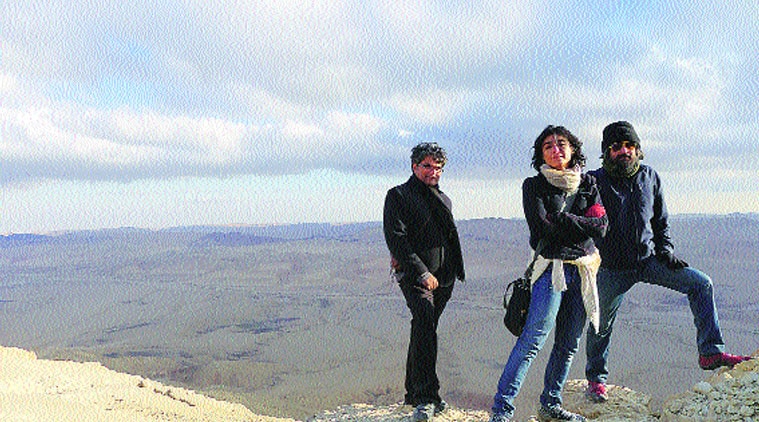Stay updated with the latest - Click here to follow us on Instagram
Whirling with Time: A conversation with Delhi-based Raqs
There are more than one kind of time-keeping devices in the exhibition.
 Members of Raqs Collective– Shuddhabrata Sengupta, Monica Narula and Jeebesh Bagchi.
Members of Raqs Collective– Shuddhabrata Sengupta, Monica Narula and Jeebesh Bagchi.
Visible from ferries to Kökar (Åland Islands) and cruise ships to Stockholm is a text sculpture in steel that arises from the Baltic Sea. It reads: More Salt In Your Tears. A public art project by Delhi-based Raqs Media Collective, it was conceptualised in 2010, and brought to attention the effect global warming has on the non-salty water body. A more recent project of the Collective aka Jeebesh Bagchi, Shuddhabrata Sengupta and Monica Narula, is Re-Run (2013), a video installation inspired by a photograph taken by Henri Cartier-Bresson in 1948 in Pre-Communist China. They’ve exhibited far and wide for 22 years, and have also dabbled smoothly with curatorial projects, think “Manifesto”, “Sarai Reader 09” and “Inset 2014”. As the Delhi-based trio presents “Asamayavali / Untimely Calendar”, their heftiest show till date in the last 22 years , they insist this is not a retrospective. Excerpts from an interview:
On genesis and evolution
We met in MCRC, Jamia Milia University, while we were working on our first 16mm film, Half the Night Left, and the Universe to Comprehend, which is now lost. When we graduated, it was time for the first television boom, and we felt that instead of getting sucked into the TV industry, it would be nice to keep our conversation going. That’s how Raqs was formed in 1992. ‘Raqs’ comes from the state of what happens to whirling dervishes when they whirl.
On “Untimely Calendar” which has close to 50 works; some of them new, some of them old, and some revisitations of past works
What continues with this show is a certain concern with the asking of questions, and the using of space of contemporary art as a platform for a kind of playful philosophical reflection. What has changed is that we have never had such a situation where so much of our work was shown at the same time. Also, we are working quite consciously through the structure of this space at NGMA. The building has also become a character in the show.
On their long standing preoccupation with the plurality of time, and the web that grazes all their work
There are more than one kind of time-keeping devices in the exhibition. There’s a 24 hour clock — this one’s brand new and deals with different notions of time. Called Night and Day and Day and Night – raat din, din raat, it has 24 Hindi words such as adi, tithi, athithi…
In our view, the work of art takes place in the viewer’s mind. All objects and images are triggers for experiences that we believe can take place within the viewer. You can be triggered in one direction and that may find an echo in another work. There’s The KD Vyas Correspondence (a work which has never been shown in India before this). In this, a man called Vyas writes to us, and we realise that he is Vyas, the re-enactor of the Maha-bharata. This index of 18 video letters lead you to A Brief History of Photography, which is about the images that the soldiers of the World War II sent back home.
On the working of the Collective, and how they have put their personal favourites aside
We work with films, objects, text-based works, and objects that shuttle between text and image. There’s also fabric and animation. We disagree with each other about a lot of things, and some of those have continued for 22 years. We may have different favourites at different times, but we always work at the intersection of our ideas. The author of the work is never one of us; the author is Raqs, which is the product of our conversation.
On being branded too cerebral with their past work
We began by being struck by wonder, by the intensity of the city we lived in. Lot of our work is rooted in Delhi as a city, and it was an attempt to understand the world from here. That remains important but it has moved to a situation where we are asking why the world is how it is, not just what it is. Our questions have become more playful and now we take ourselves a little less seriously. There’s less anxiety now, and that happens when you become more relaxed with your work.
On being grounded more with international audiences, and the changing face of the art world in India
We’ve worked across the globe, in Damascus, Jerusalem, Kabul, Norway… we’ll be showcasing in Mexico and Argentina next, in 2015.
Although it’s true that our work is somewhat better known internationally than it is here, that’s changing as there’s much more interest here. We don’t really have any institutional parameters for contemporary Indian art that are able to address a new work when it comes, so people wait for international recognition to come first. Hopefully that’ll change too. There’s clearly a greater public interest in contemporary art now, as the recent art fairs, the Kochi-Muziris Biennale or the increased footfall in NGMA show. The art world here is quite content to be small and insular, but the interest in art is actually much greater that the art world’s limits.
The show is on at NGMA, Jaipur House, India Gate, till February 15. Contact 23382835







